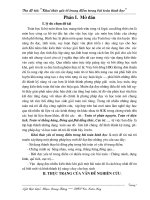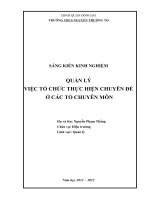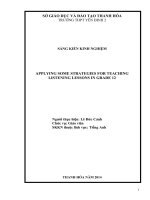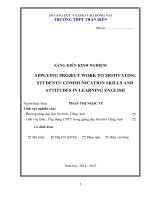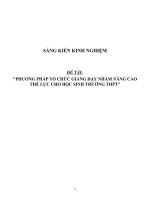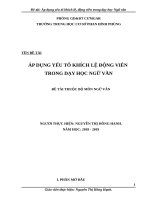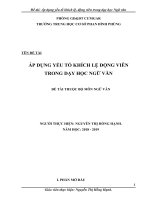SÁNG KIẾN KINH NGHIỆM APPLYING PROJECT WORK TO MOTIVATING STUDENTS COMMUNICATION SKILLS AND ATTITUDES IN LEARNING ENGLISH
Bạn đang xem bản rút gọn của tài liệu. Xem và tải ngay bản đầy đủ của tài liệu tại đây (467.86 KB, 19 trang )
1
SỞ GIÁO DỤC VÀ ĐÀO TẠO ĐỒNG NAI
TRƯỜNG THPT TRẤN BIÊN
Mã số:
SÁNG KIẾN KINH NGHIỆM
APPLYING PROJECT WORK TO MOTIVATING
STUDENTS' COMMUNICATION SKILLS AND
ATTITUDES IN LEARNING ENGLISH
Người thực hiện: PHAN THỊ NGỌC TÚ
Lĩnh vực nghiên cứu:
- Phương pháp dạy học bộ môn: Tiếng Anh
- Lĩnh vực khác: Ứng dụng CNTT trong giảng dạy bộ môn Tiếng Anh
Có đính kèm:
Mô hình Đĩa CD (DVD) Phim ảnh Hiện vật khác
Năm học: 2014 - 2015
Contents
LÝ LỊCH KHOA HỌC …………………………………………… 2
INTRODUCTION …………………………………………… 3
LITERATURE REVIEW …………………………………………… 3
Conceptual Background …………………………………………… 3
Reality …………………………………………… 5
PROCEDURES …………………………………………… 6
IMPLICATIONS AND SUGGESTION FOR TEACHING ……… 8
CONCLUSIONS AND DISCUSSION ……………………………… 11
References ………………………………………… 11
Appendix 1 ………………………………………… 13
Appendix 2 ………………………………………… 14
PHIẾU NHẬN XÉT, ĐÁNH GIÁ ………………………………… 16
2
SƠ LƯỢC LÝ LỊCH KHOA HỌC
––––––––––––––––––
I. THÔNG TIN CHUNG VỀ CÁ NHÂN
1. Họ và tên: PHAN THỊ NGỌC TÚ
2. Ngày tháng năm sinh: 09 – 03 – 1976
3. Nam, nữ: Nữ
a. Địa chỉ: 42/9 đường Đặng Đức Thuật, khu phố 6, phường Tam Hiệp,
thành phố Biên Hòa, tỉnh Đồng Nai.
4. Điện thoại: 091 3 755 399 E-mail:
5. Chức vụ: Giáo viên
6. Nhiệm vụ được giao: Giảng dạy tiếng Anh các lớp 10D4 – 11D4 – 11D5
và chủ nhiệm lớp 11D4
7. Đơn vị công tác: Trường THPT Trấn Biên
II. TRÌNH ĐỘ ĐÀO TẠO
- Học vị cao nhất: Thạc sĩ
- Năm nhận bằng: 2013
- Chuyên ngành đào tạo: Phương pháp giảng dạy tiếng Anh.
III. KINH NGHIỆM KHOA HỌC
3
- Lĩnh vực chuyên môn có kinh nghiệm: giảng dạy tiếng Anh bậc PTTH .
Số năm có kinh nghiệm: 15
- Các sáng kiến kinh nghiệm đã có trong 5 năm gần đây:
• Thành lập và duy trì câu lạc bộ Tiếng Anh ở trường THPT (2011-
2012)
• Evaluating a website to teach English (2012-2013)
• CALL-activities to stimulate students’ autonomy (2013-2014)
APPLYING PROJECT WORK TO MOTIVATING
STUDENTS' COMMUNICATION SKILLS AND
ATTITUDES IN LEARNING ENGLISH
INTRODUCTION
From 2001, the Prime Minister of Vietnam made a decision of approval on
the project “Integrating environmental issues in the general education”. Nowadays,
teachers are still requested to take advantage of environmental contents in
curriculum of different subjects to “equip student with knowledge of ecology,
environmental preservation skills and attitudes towards surrounding
environment”(Government, 2001 , p.1). In reality, this integration is not at all easy.
Both teacher and student are faced with a huge workload, time constraints and lack
of environmental materials. Therefore, it is necessary to seek an option that both
provide scaffolding support for students with sufficient materials and motivate
students’ attitudes toward learning English.
The purpose of the study was to investigate the effects of project-based learning to
motivating students' communication skills and attitudes towards English lesson of
11
th
grade students. The research was carried out in 2014 – 2015 education-
instruction year at Tran Bien high school in Bien Hoa city. Totally 72 students in
two different classes in the 11
th
grade of this school participated in the study.
LITERATURE REVIEW
Conceptual Background
Project work is a dynamic approach to teaching in which students explore
4
real-world problems and challenges, simultaneously developing cross-curriculum
skills while working in small collaborative groups or individuals to combine the
investigating the topic and presenting it in written form illustrated with photos,
pictures, diagrams, etc. (Blumenfeld et al., 1991; Đỗ, 2011). Project work is
student-centred and driven by the need to create an end-product (Bell, 2010).
However, it is an itinerary to achieving this end product that makes project work
so worthwhile. The process to the end-product brings opportunities for students to
develop their confidence and independence and to work together in a real-world
environment by collaborating on a task which have they defined for themselves
and which has not been externally imposed (Blumenfeld et al., 1991).
The basis of project-based approaches is hardly new. Early in the 1920s,
Project-based instruction was advocated by William Heard Kilpatrick. His notion
was that such instruction should include four components: purposing, planning,
executing, and judging (Foshay, 1999). Since the students learn with interactive
technology and since the teacher has to design, to facilitate and to monitor
student activities. Thomas (1999) stated that the idea of assigning projects to
students is not a new one and the benefits of learning by practice have long been
touted; the roots of the idea go back to John Dewey (Blumenfeld et al., 1991;
Foshay, 1999). While each of these designs has different pedagogical objectives,
we believe that all good pedagogical designs should include somewhat
structured pedagogical scenarios
and that the teacher's role is crucial. For over
100 years, educators such as John Dewey have reported on the benefits of
experiential, hands-on, student-directed learning. Doing and creating projects is a
long-standing tradition in education history (Merkham et al., 2003).
A project-based activity allows our students to identify and project their own
problems. They become active, not passive; a project engages their hearts and
minds, and provides real-world relevance for learning. Besides that students
develop a question and are guided through research under the teacher‘s
supervision (Bell, 2010). Instead of using a inflexible lesson plan that directs a
learner down a specific path of learning outcomes or objectives, project-based
learning allows in-depth investigation of a topic worth learning more about.
Thomas (1999) also described projects within project-based learning as based on
challenging questions and making students having central role in problem-
solving, designing skill, negotiation and decision making processes so giving
students the chance to work relatively autonomously. In project-based learning
activities, students plan, implement, and evaluate projects that have real-world
applications beyond the classroom (Blank,1997). Project-based learning is an
active approach to classroom teaching and learning that is designed to engage
students in investigation of complex, authentic problems and carefully designed
products and tasks (Blumenfeld et al., 1991). The use of project-based learning in
class is possible after providing the information that is needed for the project. The
classroom activities should be student-centred, cooperative, and interactive
(Moursund, 1999).
5
Based on gathered evidence over the past years, project-based learning
appears to be effective model for producing gains in academic achievement.
Project-based learning enhances the quality of learning and leads to higher-level
cognitive development through the students’ engagement with complex and novel
issues (Blank, 1997). Students not only access to a broader range of learning
opportunities in the classroom, providing a strategy for engaging culturally diverse
learners (Railsback, 2002) but also are exposed to a wide range of skills and
competencies such as collaboration, project planning, decision making, and time
management through project- based learning (Blank, 1997). There is not sufficient
research or empirical data to be able to express certainty that project-based
learning is a proven alternative to other forms of learning. Project-based learning
increases the students’ attitutes of mind students toward their learning style.
Project-based learning is still in the developmental stage within educational
settings. Moreover, these studies which were on the investigation of project-
based learning were carried out in elementary level by comparing project-based
learning with traditional methods. However, this study focuses on the effects of
project-based learning with comparison to the student textbooks based-instruction,
which were created on the basis of the new 11
th
Grade English Curriculum. From
this perspective, this research can be stated to have a significant value. In this
sense, It is hoped that this empirical study can provide a close link between
project
- based learning and language learning and, at the same time, propose
guidelines for English language teachers who wish to implement project-based
learning to enhance their students’ language learning as well as development of
attitude towards learning English as a foreign language. On the other hand, by
carrying out this study, we hopes that project-based learning can receive more
attention and enjoy more popularity among teachers of English at all grade levels.
Reality
From grade three on, English is taught at Primary school. This demand for
English offers opportunities for Teaching English as a Second or Other Language
(TESOL) in Vietnam but at the same time this creates not only many challenges
but also mismatchs between the expected and actual levels of competence, and
educators claim EFL preservice teacher education is largely inadequate (Pham,
2001). We have changed our English Curriculum from Primary school to High
school in order to get language proficiency levels and interpret language
qualifications defined in the Common European Framework of Reference for
Languages (CEFR), which plays a central role in language and education policy
nationwide. Morover, we have done our best to inspire our students to study
English, using different modern teaching methods, applying CALL – activities
(Computer-assisted language learning) into our teaching stage and renovating
testing system.
As a shown in the problem indenfication of the motivation in English
learning process through traditional methods, it’s possible to confirm that the
solution to the problem is related to the working hypothesis which is the solution
6
for the lack of motivation on students. PBL (Project-Based Learning) will increase
their interest to use contents of English classes and to improve basic skills for the
understanding and communication in English language. To apply the proposal of
this research based on the application of PBL to motivate English learning, in order
to improve English communication skills and students’ attitudes in learning.
Figure 1: Problem indenfication
PROCEDURES
In the experimental group, cooperative learning method was applied. Whereas,
in the control group instruction based student textbooks was used in the process
of the study.
This instructional treatment was conducted the 2014-2015 academic year at Tran
Bien high school. 11
th
grade students of two classes of this school were enrolled
in the study. Firstly, the academic achievement test and English attitude scale
were performed as a pre-test. In the next step, the speaking activities in unit 3 -
Party of the Grade 11
th
English Curriculum was taught to the control group by
using the instruction based on the project-based activities through student
textbooks
After the topics to be studied were selected, the teacher developed an
instruction programme. It was crucial to develop appropriate techniques and
provide necessary materials that reflect the principles of project - based learning
7
(See Appendix 1).
In the experimental group, the students were taught with project-based
learning developed for activities in student textbook prepared in connection with
the Grade 11
th
English Curriculum. So, the instruction programme for the
experimental group was prepared according to the principles of project-based
learning. Project-based learning is based on the idea that students study a specific
subject in a deeper context. In this regard, the teacher explained the key
concepts in the unit to the students. During the lesson, though occasionally, the
teacher asked questions to the students based on activities (vocabulary, grammar
and speaking) in order to encourage participation of the students in the learning
process. The teacher also made presentations based on the reading, listening and
grammar passages in the textbooks. At the end of the instruction, the teacher
asked some questions about the related passages and let the students do the
activities given in the textbooks. The teacher made the students do the activities in
the student textbooks while standing at front of the class and received the answers
and gave them feedback, recorded subject notes on the board, and gave daily
homework to the students.
Most lessons passed as the students doing the activities in student textbooks,
taking short notes and answering teacher questions. The teacher gave the students
necessary time to do the activities in the textbooks. The teacher played the role of
facilitator during the learning process in the classroom.
After the key concepts, steps and procedures about project-based learning
were presented and explained to the students, the teacher and the students
created certain objectives for each group mutually and then they defined the
work and the subjects in the learning process. In order to form the project
groups, the students were made to count from one to seven, the eighth student
stated to count from one and the others went on counting again. By grouping
those with the same number, it was ascertained that each group became random in
nature and classroom organisation became convenient for project-based learning.
After sharing the tasks, the teacher clarified what was expected from the students.
During the project, the students’ task was to study the presented materials,
obtain relevant information, create the project and then present it in front of
their friends in the classroom. Before starting to create the project, the students
were assigned to project groups and they were given the tasks. The students were
made to create study calendars and determine control points in the study calendars.
Each project group was given the necessary materials presenting the target tasks
and information, then they were let create their projects in the groups. At the end
of a
four
-week study in project groups, the students presented their projects in
front of the classroom and received feedback both from the teacher herself and
their peers in the classroom. In relation with the evaluation, the projects were
evaluated by the students in other groups and the teacher with (1) teacher
evaluation and (2) peer evaluation forms. After scoring the projects of the groups,
the students of the best three projects earned some certificates and awards. Thus,
8
the students in the groups competed with the other groups instead of their team or
class mates. At the end of the project-based learning process, all the projects
created by the groups were presented to the other students and teachers in some
certain parts of the school (See Appendix 2). Meanwhile, the teacher served both
as a designer and a facilitator in the learning process. The teacher formed the
groups, prepared the materials and presented the principles and procedures of
project-based learning as a designer and he walked around the classroom and
helped the students who needed help as a facilitator during the learning process.
From the students’ studying procedures, it can be said that the students in the
experiment group have reached higher attitude scores. The experimental method
applied has enabled the students to develop positive attitudes towards English
lesson. The application of PBL to motivate English Learning on students will
increase their interest to communicate in English language ideas and to develop
basic language skills.
How does this fabric transform a more traditional classroom? The answer for
this question can be seen through students’ development presentation described a
classroom where the teacher is using the project-based learning model effectively.
In such a setting:
• Students have an oppotunities to reflect on the activities.
• There is an atmosphere that error and change are tolerated.
• Students face to the problem with no predetermined answer.
• The process for reaching a solution can be designed.
• Decisions are made with a framework.
• Assessment takes place continuously.
• A final product results and is evaluated for quality.
For students accustomed to a more traditional school experience, this means a
transformation from following orders to carrying out self-directed learning
activities; from memorizing and repeating to discovering, integrating, and
presenting; from listening and reacting to communicating and taking
responsibility; from knowledge of facts, terms, and content to understanding
processes; from theory to application of theory; from being teacher dependent to
being empowered
EXPECTED OUTCOME:
• Students will be able to use their English knowledge in an interesting and
creative project will begin to like English more.
• Students will learn how to use technology for learning purposes and not just
for entertainment.
• Other teachers of English and other subjects also become more involved
9
with Project-Based Learning and use these kinds of projects to stimulate
their students learning capabilities.
IMPLICATIONS AND SUGGESTION FOR TEACHING
Based on the overall findings in the process of completing their projects,
students also hone their organizational and research skills, develop better
communication with their peers and adults, and often work within their
community while seeing the positive effect of their work.
Because students are evaluated on the basis of their projects, rather than
on the comparatively narrow rubrics defined by exams, essays, and written
reports, assessment of project-based work is often more meaningful to them.
They quickly see how academic work can connect to real-life issues - and may
even be inspired to pursue a career or engage in activism that relates to the
project they developed.
Students also thrive on the greater flexibility of project learning. In addition to
participating in traditional assessment, they might be evaluated on presentations
to a community audience they have assiduously prepared for, informative tours
of a local historical site based on their recently acquired expertise, or screening
of a scripted film they have painstakingly produced.
What are the challenges facing teachers?
When we bring project-based learning into the classroom we may have to
adopt new instructional strategies to achieve success. Having the teacher take the
role of guide or facilitator is not the way that most educators were taught, nor even
the way they were taught to teach. Direct-instruction methods that rely on
textbooks, lectures, and traditional assessments do not work well in the more open-
ended, interdisciplinary world of project-based learning. Rather, we do more
coaching and modeling and less "telling." Specific challenges facing teachers
include:
• Recognizing situations that make for good projects;
Assigning an authentic task; project-based work is supposed to be about the
real world and reflect things that people out in the real world actually care about
and need to know. This means that the teacher need to stay away from tasks that
seem to “live” only is schools such as asking them to write an essay or transform
sentences. Instead, the tasks should reflect things that people in the real world
engage in or need to know.
• Structuring problems as learning opportunities;
Using an appropriate topic; not every topic works as a project-based work –
it’s just that simple. But even beyond that, we have to find the chosen topics
engage the student in the way that we hope it would. That’s why it’s so important
to forcus on big, specific issues that are relavent to them or that reflect some
aspects of their interest. We’re most motivated to learn when the task before us is
10
matched to our student level of skill: not so easy as to be boring, and not so hard as
to be frustrating. Deliberately fashion the learning exercise so that students are
working at the very edge of their abilities, and keep upping the difficulty as they
improve.
• Managing the learning process;
Assigning a unique task; the poin of view project-based learning is to engage
the students in a task that seems new, exciting and interesting. There a good chance
that they’re going to be very interested. Specially, project-based activities are good
at teaching procedures to students or at helping them to memorize fact, so include
these things as part of their task will miss the point of PBL. Memorizing
information is boring. Discovering the solution to a puzzle is invigorating. Present
material to be learned not as a fait accompli such as state high school curricula, but
as a live question begging to be explored. Some learning tasks, like memorizing
the multiplication table or a list of names or facts, are simply not interesting in
themselves. Generate motivation by encouraging students to compete against them:
run through the material once to establish a baseline, and then keep track of how
much they improve (in speed, in accuracy) each time.
• Integrating technologies where appropriate;
Choosing multi-faceted resources; part of what a project-based learning is
supposed to do is present different points-of-view and get student to from their
own opinions after reading about “facts” that often oppose each other. Therefore,
that’s not easy to do if we use resources that all seem to be staying the same things.
Project-based learning can be applied to all age-group, and all levels in which
students have to collect information from website, seveys, and interviews. Besides,
Internet use can bring back students advantage of opportunities to be taught critical
thinking skills.
• Collaborating with colleagues to develop interdisciplinary projects;
Developing authentic assessments indeed, we may have to be willing to take
risks to overcome initial challenges. Almost students do projects at the same time.
They complain that they have more than three projects due in the same week.
Therefore, we should talk to one another and space projects out over the course of
the year. This would result in higher quality projects. A supportive administration
can help by implementing more flexible schedules, such as block schedules or
team planning time, and providing teachers with professional development
opportunities.
According to my observation, the best way to know if we have created a
successful project-based activity is if our students come up with different answer to
the same problem. This way, we know that they have engaged with the topic and
formed their own distinctive viewpoints based on the information. As our world
continues to increase in speed and complexity, this kind of higher-lever thinking is
going to be invaluable to ensure that they have a successful future. On the other
11
hand the teacher should be well trained and embrace the constructivist
methodological principles that are supported by the usage of this tool.
As a teacher of English in high school we can see that the use of acquiring
project-based ware can open the door for incorporating other teaching chg tools in
while accommodating the needs of new generation of students who are currently or
will come into classrooms. It is possible that using project-based ware as a
constructivist internet based tool will also help meet the school modernization and
technology incorporation push currently underway by the MOET as part of an
attempt to reach the modernization standards set bay the most developed countries
CONCLUSIONS AND DISCUSSION
The results of the research showed a significant difference between the
attitude scores of the experiment group and the control group. On the other hand, it
was also found out that project-based learning was more effective in the positive
development of the students’ academic achievement levels. At the end of the
research, it was revealed that the students who were educated by project-based
learning was more successful and had higher attitude levels towards the lesson
than the students who were educated by the instruction based on student
textbooks.
The purpose of this study was to investigate the effects of project-based
learning on academic achievement and attitudes of eleventh grade students
towards English lesson and to compare it to that of instruction based on student
textbooks. For this reason, experimental groups were formed for the study.
Whereas project-based learning was applied to the experimental groups,
instruction based on student textbooks was applied to the control group in the
teaching stage; there was no significant difference between the experimental and
control groups in terms of their academic achievement scores in English lesson.
The findings of post-test at the end of the implementation, however, indicate that
the experimental group performed better than the control group. The difference
acquired between these two groups can be attributed to the responsibilities that the
students took in project-based learning, the active role of the students in the
learning process. Working in the groups, which project-based learning was
employed made the students learn the responsibility, provided them with
motivation to learn, and enabled them to acquire knowledge by receiving different
ideas and understanding the others point of view in the lesson.
References
Bell, S. (2010). Project-based learning for the 21st century: Skills for the future.
The Clearing House, 83, 39-43.
Đỗ Ngọc Thống. (2011). Xây dựng chương trình Giáo dục phổ thông theo hướng
tiếp cận năng lực. Retrieved from />tabid=62&News=4119&CategoryID=6
12
Blank, W. (1997). Authentic instruction. Blank, W. E. and Harwell, S.
(Eds.). Promising practices for connecting high school to the real world. Tampa,
FL: University of South Florida.
Blumenfeld, P., Soloway, E., Marx, R., Krajcik, J., Guzdial, M. and Palincsar, A.
(1991). Motivating
project
- based learning: Sustaining the doing, supporting the
learning. Educational Psychologist, 26(3-4), 369-398.
Retrieved from;
/> />Foshay, J. D. (1999). Project-based multimedia instruction. Bloomington, IN: Phi
Delta Kappan International. Fraenkel, J. R. and Wallen, N. E. (1996). How to
design and evaluate research in education. (3rd ed.). New
York: McGraw-Hill.
Merkham, T., Mergendooler, J., Learmer, J. and Ravitz, J. (2003). Project based
learning handbook. Hong Kong: Quinn Essentials Books and Printing, Inc.
Moursund, D. (1999). Project-based learning using information technology.
Eugene, Oregon: International Society for Technology in Education.
Pham, H. H. (2006). Researching the Research Culture in English Language
Education in Vietnam. Journal, 10(2). Retrieved from http://www-
writing.berkeley.edu/TESLEJ/ej38/a10.html
Railsback, J. (2002). Project-based instruction: Creating excitement for learning.
Portland, OR: Northwest Regional Educational Laboratory.
/>Thomas, J. W. (2000). A review of research on project-based learning executive
summary. San Rafael, CA: The Autodesk Foundation.
Thomas, J. W., Mergendoller, J. R. and Michaelson, A. (1999). Project-based
learning: A handbook for middle and high school teachers. Novato, CA: The Buck
Institute for Education.
Educational Technology Division Ministry of Education Malaysia. (2006). Project-
Based Learning Handbook “Educating The Millennial Learner” Retrieved from
/>%20Learning%20Handbook/2%20-%20Project%20Based%20Learning
%20Handbook.pdf
13
Appendix 1
16 September, 2014
Project 1: BEST PARTY – Group ……… Class: 11D
• Students use the context of party planning to practice talking about how to
organize the best party. Decide on the following:
- budget
- date and time
- who to invite
- place
- formal or informal dress
- decoration
- entertainment (music, game, etc)
- food and drink
Tell the rest of the class about your party. Try to convince them
to come.
Sources:
www. birthdayparty ideas.com
www. fingertips .com
English 11 – Unit 3: A party
Date: 7
th
week. From Sep 16 to Sep 25
Project theme:
……………………………………………………………
……………………………………………………………
……………………………………… …………………
Note: You have to make a presentation to show and present your project.
You will get mark for oral test. If the presentation is well-done, you
will have bonus mark for 15’ test.
Group members
Topic …………………………………………………………… Class: 11D …
14
Order Name Role in the project PP OP Individual Total
1
2
3
4
5
6
Note
PP
PowerPoint for presentation in classroom (10
marks)
OP
Oral presentation (10 marks)
Individual
Students's handout (10 marks)
Total score = (PP + OP + dividual)/3
Due date:
PowerPoint for presentation ………………………………………….
Oral presentation ……………………………………………
Students's handout ………………………………………………
Appendix 2
15
SỞ GD&ĐT ĐỒNG NAI
TRƯỜNG THPT TRẤN BIÊN
CỘNG HOÀ XÃ HỘI CHỦ NGHĨA VIỆT NAM
Độc lập - Tự do - Hạnh phúc
16
–––––––––––
––––––––––––––––––––––––
Biên Hòa , ngày 19 tháng 5 năm 2015
PHIẾU NHẬN XÉT, ĐÁNH GIÁ SÁNG KIẾN KINH NGHIỆM
Năm học: 2014 - 2015
–––––––––––––––––
Tên sáng kiến kinh nghiệm: APPLYING PROJECT WORK TO MOTIVATING
STUDENTS' COMMUNICATION SKILLS AND ATTITUDES IN LEARNING
ENGLISH.
Họ và tên tác giả: PHAN THỊ NGỌC TÚ Chức vụ: Giáo viên
Đơn vị: TRƯỜNG THPT TRẤN BIÊN
Lĩnh vực: (Đánh dấu X vào các ô tương ứng, ghi rõ tên bộ môn hoặc lĩnh vực khác)
- Quản lý giáo dục - Phương pháp dạy học bộ môn: Tiếng Anh
- Phương pháp giáo dục - Lĩnh vực khác: Ứng dụng CNTT trong giảng dạy bộ môn Tiếng
Anh
Sáng kiến kinh nghiệm đã được triển khai áp dụng: Tại đơn vị Trong Ngành
1. Tính mới (Đánh dấu X vào 1 trong 3 ô dưới đây)
- Đề ra giải pháp thay thế hoàn toàn mới, bảo đảm tính khoa học, đúng đắn
- Đề ra giải pháp thay thế một phần giải pháp đã có, bảo đảm tính khoa học, đúng đắn
- Giải pháp mới gần đây đã áp dụng ở đơn vị khác nhưng chưa từng áp dụng ở đơn vị mình,
nay tác giả tổ chức thực hiện và có hiệu quả cho đơn vị
2. Hiệu quả (Đánh dấu X vào 1 trong 5 ô dưới đây)
- Giải pháp thay thế hoàn toàn mới, đã được thực hiện trong toàn ngành có hiệu quả cao
- Giải pháp thay thế một phần giải pháp đã có, đã được thực hiện trong toàn ngành có hiệu
quả cao
- Giải pháp thay thế hoàn toàn mới, đã được thực hiện tại đơn vị có hiệu quả cao
- Giải pháp thay thế một phần giải pháp đã có, đã được thực hiện tại đơn vị có hiệu quả
- Giải pháp mới gần đây đã áp dụng ở đơn vị khác nhưng chưa từng áp dụng ở đơn vị mình,
nay tác giả tổ chức thực hiện và có hiệu quả cho đơn vị
3. Khả năng áp dụng (Đánh dấu X vào 1 trong 3 ô mỗi dòng dưới đây)
- Cung cấp được các luận cứ khoa học cho việc hoạch định đường lối, chính sách:
Trong Tổ/Phòng/Ban Trong cơ quan, đơn vị, cơ sở GD&ĐT Trong ngành
- Đưa ra các giải pháp khuyến nghị có khả năng ứng dụng thực tiễn, dễ thực hiện và dễ đi vào cuộc
sống: Trong Tổ/Phòng/Ban Trong cơ quan, đơn vị, cơ sở GD&ĐT Trong ngành
- Đã được áp dụng trong thực tế đạt hiệu quả hoặc có khả năng áp dụng đạt hiệu quả trong phạm vi rộng:
Trong Tổ/Phòng/Ban Trong cơ quan, đơn vị, cơ sở GD&ĐT Trong ngành
Xếp loại chung: Xuất sắc Khá Đạt Không xếp loại
Cá nhân viết sáng kiến kinh nghiệm cam kết và chịu trách nhiệm không sao chép tài liệu của
người khác hoặc sao chép lại nội dung sáng kiến kinh nghiệm cũ của mình.
17
Tổ trưởng và Thủ trưởng đơn vị xác nhận đã kiểm tra và ghi nhận sáng kiến kinh nghiệm này
đã được tổ chức thực hiện tại đơn vị, được Hội đồng chuyên môn trường xem xét, đánh giá; tác
giả không sao chép tài liệu của người khác hoặc sao chép lại nội dung sáng kiến kinh nghiệm cũ
của chính tác giả.
NGƯỜI THỰC HIỆN SKKN
Phan Thị Ngọc Tú
XÁC NHẬN CỦA TỔ
CHUYÊN MÔN
Nguyễn Thị Thanh Hồng
THỦ TRƯỞNG ĐƠN VỊ
Nguyễn Văn Hưng
18
